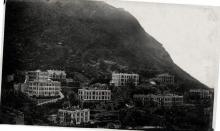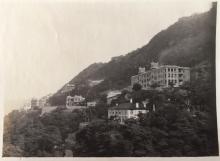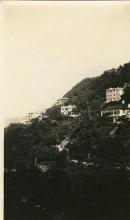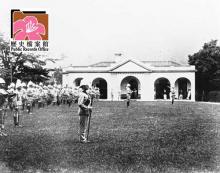Mr Brewin's House [????-????]
Primary tabs
Submitted by marlowe on Sun, 2015-10-25 17:02
Current condition:
Demolished / No longer exists
Identified on a map (which I can't find at the moment) as Mr Brewin's House.
He could be the Mr Brewin who was on the legislative council.
At the end of Brewin Path.
(IL 1772)





Comments
EWO / Jardine's Mess
Copied from https://gwulo.com/atom/37261#comment-54853 by John Fraser Bowden:
The building shown is noted elsewhere in Gwulo https://gwulo.com/atom/29043 as Mr Brewins House but in 1955 when my parents moved into the building that replaced it, it was No.2 May Road, later changing in the late‘60s to No. 7.
There are references in Gwulo to the site being Brewin Mansions in the 1970's but I don’t recall ever using that name or seeing it on signage.
Dad had some stories about the building that he moved into in 1948 – the one in the picture, Brewins House as it had been - as a newly arrived Jardine bachelor. During the war the building accommodated neutral-nation foreign nationals including Mr. Willy Dubois who lived there through the difficult war years and went on to manage Sennet Freres Jewelers on Pedder Street. The foreign nationals from neutral countries were nominally protected there but were also heavily restricted by the Japanese in movement and supplies. Willys' children were all born in Hong Kong post war and his wife, daughters and son are currently resident in Switzerland.
After the war Jardine’s took the building over because it hadn’t been damaged or looted and could be ‘converted’ into accommodation for single men arriving in Hong Kong to restart the company business. When Dad arrived there was still a Japanese note nailed to the door informing people that the occupants had permission to live there. The conversion to a Mess – accommodation for single men generally aged 20-30 - was somewhat haphazard with the arch-windowed verandahs being turned into bedrooms that had to be accessed through the rooms inside, which consequently lost much of their daylight. Along the verandah only wooden closets separated the ‘rooms’. Privacy was not a priority. On his first night, after flying for almost a week by seaplane from London, he dressed for dinner, only to arrive in the dining room to see a crowd of young men in various stages of undress, towels round their waists (it was summer) and no hint of the colonial formality he had expected. He quickly learned to adapt.
The food they ate was paid for by a pool of cash to which all occupants contributed and was managed by an appointed member of the residents ( I think he suggested there were 15-20 in there) and spent by the Number One Boy in ways that they had no control over at all. Mismanagement of funds was not uncommon by residents and staff alike.
Dad had one of the verandah ‘rooms’ and thoroughly enjoyed his time there. All the young men had come from the recent war, from different branches of the Services and different areas of combat. They were from entirely different social and family backgrounds but had that strong military bond that overcame other differences. Most were still active members of the Defense Force in Hong Kong, spending many of their weekends on ships, planes or marching around.
They were sport crazy and got up to all the things that young men in a tight-knit group are known for. Ladies were not allowed into the Mess, of course.... As the years went by he became more settled in his job and in life at the Mess. There were dogs (mostly spaniels) and he had a car which he claims he drove up the driveway but had to reverse back down. That driveway is still there but it isn’t the one leading to May Towers which stands on the site now. It’s the narrow footpath round the corner and just above the start of Brewin Path. How he did it I have no idea. But he seems to have made a habit of driving up narrow roads.
Others kept their cars on May Road. In 1951 he did it again, taking his open-topped car along narrow Lugard Road to a party at the Swires Mess located at No.27. He said it was the only time that the Swire Boys invited the Jardine’s Boys to their lair. He claims to have walked in through the door, seen a beautiful young lady at the bottom of the staircase and decided he would marry her. Having done that a year later he had to move from the Mess on May Road. Jardine’s put him, my mother and several other newly-wed couples from that Mess into No. 8 The Peak, near the current No.20 Mt Austin Road which seems to have been their other Mess pre-war, but had then been extended for new families.. It seems to have been another poorly ‘converted’ building that Mum said leaked like a sieve, was cold in winter and no place to bring up children. But accommodation even that long post-war was in short supply.
My sister Nicky was born in 1954 at the Matilda and returned to No.8. Mum began a campaign to be rehoused and they moved back to No.2 May Road in early 1956 and I was born that year. Some time in the 4 years prior the old house had been demolished and a new block of 4 floors, 2 flats per floor plus a penthouse on top for the Jardine’s CFO over car park spaces on the Ground Floor had been built. The Jardine Mess occupied the first floor and half the second, linked by a staircase internally. We were on the third floor, Flat B, a two bedroomed apartment with high ceilings, long central corridor, a very wide and 30 foot long verandah along one whole side with a clear view of the harbour and a Dry Room where everything was stored together with a dehumidifier that had to be permanently on. There were no air conditioners for some years but there was a fireplace in the Living Room and coal bunkers for each flat downstairs.
We hardly ever went into the Mess. It was considered impolite, but I recall it being better arranged than Dad’s descriptions of the previous one. Single rooms, more bathrooms, but not en suite, and common areas for Living and Dining. Nothing fancy, but perfectly decent. They still had a large team of domestic support. Cooks, amahs, cleaners, I recall at least a dozen in all. Our own amahs and cook were sourced through So Tong, their Number One Boy and nepotism was of course rife.
The garden that had served the old Brewin House remained for the block we lived in. it was mostly grass though the Fa Wong raised numerous pot plants. The garden was on a high terrace, perhaps 40 feet above the hillside with a granite retaining wall and the same balustrade that is seen in the photos of Brewins’ house. Below that and growing from the wall and down to the slope below was a massive banyan tree that had spread its roots some 6 feet perpendicular to the retaining wall rather than along its face and created a remarkable climbing frame that reached almost to the lawn at the top.
The Mess Boys had a lot more cars by then and more space was provided for them including a large concrete area cantilevered over the deep nullah on the West side, raised on stilts and always looking a bit precarious seen from underneath it. We were told NEVER to go there. They also got a proper driveway up from May Road that now serves the 2 towers that replaced THAT building in 1971. They weren’t very happy during at least 2 typhoons when the hillside above the lawn came down and poured into the garages blocking the driveway and damaging their vehicles. It was finally terraced with concrete in the late ‘60s In 1972 the building was demolished.
Our family was the last to leave. Mum had persuaded Jardine’s to let us move to newly built Grenville House, though it was way above our grade. A moving party was held and friends were invited to paint the walls in the old flat with whatever they wanted. Most of it was child suitable (two further siblings being under ten) but then the Grenville move was delayed and they had to live with the murals for several months. On the day they finally moved out there were workmen in the bathrooms smashing the baths and demolishing cabinetry as the last suitcases went out the front door. I believe that at that point Jardine’s had ceased to provide their traditional Mess accommodation, subsidizing new arrivals – male and female by then - on the open property market.